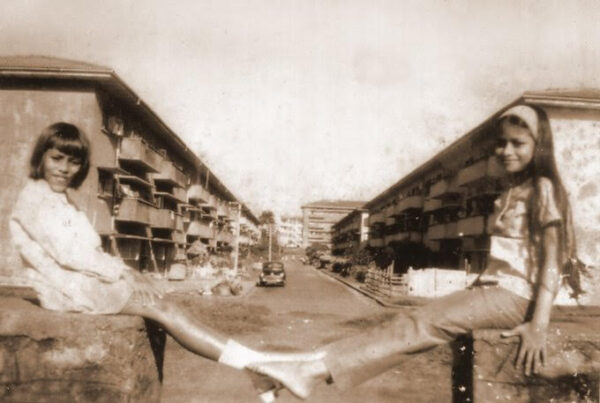Bamba in the 50’s – by Arlen van der Wall

Image source: Roar ( https://roar.media/english/life/history/the-great-days-of-bamba-life-in-the-bambalapitiya-of-the-sixties-seventies )
The Bambalapitiya strip between Lion House and Saraswathi Lodge was Colombo’s walk of fame. You did not have to be rich or famous to enter the mythologies that accompanied the virtual sidewalk stars.
Here’s where Kum and Douggie Roberts faced off. Bamba heaved and trembled as the heavies clashed. Ronnie Steinwall was a mere bystander, the story goes. Here’s where George Siegertsz lazed outside Lion House while he honed his whistle on – ‘Hitler had only one big ball…’, everybody knew he had introduced the Colonel Bogey march to the ‘Bridge on the River Kwai’. Here, it all started! And these are the Mayfair booths that were crammed with the boys that starred in the crowd scenes. Every day they returned from Kitulgala to tell tall tales of stars and stardust to their awed and envious audience. William Holden, Jack Hawkins, Alec Guinness, were the names thrown around like confetti or dropped, clumsily, like bricks. Muchang, today this hand shook the hand of Jack Hawkins…… get out you bugger…In Bamba, myths were born, fast tracked to immortality and given an address. Bamba lore was alive and well.
Bamba was the capping capital of Ceylon. 5 girl’s schools on the Galle Road mile south of Bullers Road junction, guaranteed its status. There was more cycle rubber put down on this stretch, capping, than was ever expended on destinations. And ‘cycle envy’ took hold of little boys on this stretch, long before penis envy did. Watching the squadrons of ‘Winged Wheelers’ and ‘Paragon Peddlers’ sweep past on their capping rituals, they were captivated by the machines. The bicycle was the teen status symbol of the day. A little boy’s comprehension of teenage courting rituals put the cycle at the centre of the drama. Seeing all the action on the Bamba mile, he concluded that a flashy bike was the way to a girl’s heart. All the preening and pirouetting was for naught, but for a bike. No wonder the bigger boys talked so much about their fixed cogs and hub gears, some even dreamed about derailleurs. A Raleigh Lenton or a Phillips Phantom were the stuff of wetter dreams. If you rode a sports with swept down handles you were in with a chance. A dawn or standard model – an outside chance. A girl’s bike – forget it! Your chances of success were graduated on this bicycle scale. You never stayed little, too long, on the Bamba mile. What you saw, grew you up, sometimes before time. The nexus between girls and bicycles should have lasted longer. It was a much simpler World. These times were marked for our deeper nostalgia.
The Bamba mile was Cupid’s Mecca. Schoolboys from all over Colombo gathered to have their hearts pierced. They in turn did a lot of piercing, much of it imaginary.
A furtive look and the girl became a girl friend. A shy smile and all within its radius thought her their beloved. As many arrows missed their mark as found them.
Many partnerships were lost and found on the Bamba mile. The rituals of teenage courtship were always on vibrant display.
The Bamba mile ran South on an elevated spine that tipped markedly on the beach side and less so on the other. It was bookended by the two most popular Colombo cinemas. Through them poured the American cultural assault on our British heritage. American films and music subsumed, then dominated cinemas and hit parades.
Comics and bubble gum became the scourge of educators and parents. Bamba, it seemed, was more susceptible to these influences than elsewhere.
The denizens of Bamba acquired a new label. The Bambalawatte crowd. An epithet signifying the affinity to the alien. The cultural infusions ran so deep that when the New Nationalism asserted itself, nearly all those who had succumbed to the allure, migrated.
Bang in the middle of the mile stood a testament to the virtues of affordable public housing. The Torrington flats project preceded Bambalapitiya, but was quickly eclipsed in
stature by the Bamba flats. It was as much a social experiment as a housing scheme. In less than a decade, the inhabitants had evolved their own subculture and a sense of belonging, alien to an outsider. Ethnicities and languages blended into bonds so real that when the great migration was over, the flatters re-formed their association in the new country. It is likely that a sociologist would attribute a large part of the credit to the Bamba ambience.
Bamba was a magical place in the 50’s.







